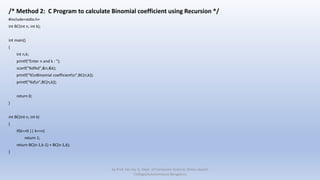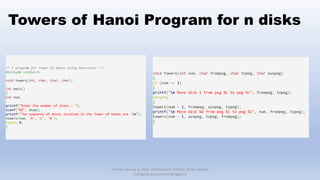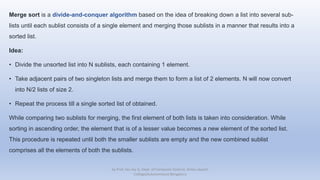The document discusses recursion and provides examples of recursive functions and algorithms. It defines recursion as defining a problem in terms of itself and provides examples of direct and indirect recursive functions. It also discusses the key parts of a recursive function - the base case, work towards the base case, and recursive call. Examples of problems that can be solved recursively include calculating factorials, summing the first n natural numbers, and computing the Fibonacci sequence. Merge sort is also summarized as a divide and conquer algorithm that works by recursively splitting a list into single element sublists and then merging them back together in a sorted order.




![Problems: Recursion can be Implemented
Example 1
Find Factorial of a given number n?
n! = n * (n-1) * (n-2) * ... 2 * 1
n! = n * [(n-1) * (n-2) * ... 2 * 1]
n! = n * (n-1)!
Base Case for factorial recursive function is
0! = 1 or 1!=1
by Prof. Jeo Joy A, Dept. of Computer Science, Kristu Jayanti
College(Autonomous) Bengaluru](https://image.slidesharecdn.com/recursionmergesortquicksort-220624122225-2514010a/85/Recursion-Merge-Sort-Quick-Sort-pptx-5-320.jpg)

![Problems: Recursion can be Implemented
Example 2
Find Sum of first n natural numbers?
Sum(n) = n + (n-1) + (n-2) + ... 2 + 1
Sum(n) = n + [(n-1) + (n-2) + ... 2 + 1]
Sum(n) = n + Sum(n-1)
Base case for Sum of first n natural numbers is
Sum(1) = 1
by Prof. Jeo Joy A, Dept. of Computer Science, Kristu Jayanti
College(Autonomous) Bengaluru](https://image.slidesharecdn.com/recursionmergesortquicksort-220624122225-2514010a/85/Recursion-Merge-Sort-Quick-Sort-pptx-7-320.jpg)













![Merge Sort - Algorithm
MergeSort(A,low,high)
[A[0….n-1] is the input array to be sorted, low and high gives the
indices of the first and last elements of the array]
IF(low<high) THEN
mid = (low + high)/2
MergeSort(A,low,mid)
MergeSort(A, mid+1,high)
Merge(A,low,mid,high)
ENDIF
by Prof. Jeo Joy A, Dept. of Computer Science, Kristu Jayanti
College(Autonomous) Bengaluru](https://image.slidesharecdn.com/recursionmergesortquicksort-220624122225-2514010a/85/Recursion-Merge-Sort-Quick-Sort-pptx-21-320.jpg)
![merge(A,low,mid,high)
[A[0….n-1] is the array where low give the index of the first and high gives
the index of the last element under consideration, mid gives the index of
the middle element]
[Initialize the Variables]
Step 1:
i=low
h=low
j=mid+1](https://image.slidesharecdn.com/recursionmergesortquicksort-220624122225-2514010a/85/Recursion-Merge-Sort-Quick-Sort-pptx-22-320.jpg)
![[ Do merging process until one of the subsets get exhausted for the two sorted subsets
A[low..mid] and A[mid+1…high] after comparing the first element from each subset each time ]
Step 2:
WHILE (h<=mid and j<=high) DO
IF(A[h] <= A[j]) THEN
B[i] = A[h]
h = h+1
ELSE
B[i] = A[j]
j = j +1
ENDIF
i = i + 1
ENDWHILE
by Prof. Jeo Joy A, Dept. of Computer Science, Kristu Jayanti
College(Autonomous) Bengaluru](https://image.slidesharecdn.com/recursionmergesortquicksort-220624122225-2514010a/85/Recursion-Merge-Sort-Quick-Sort-pptx-23-320.jpg)
![[First subset gets exhausted, add remaining elements of second subset to the resultant
set]
IF h>mid, THEN
FOR k=j to high DO
B[i] = A[k]
i=i+1
k=k+1
ENDFOR
ELSE [Second subset gets exhausted, add remaining elements of first subset to the
resultant set]
FOR k=h to mid DO
B[i] = A[k]
i=i+1
k=k+1
ENDFOR
by Prof. Jeo Joy A, Dept. of Computer Science, Kristu Jayanti
College(Autonomous) Bengaluru](https://image.slidesharecdn.com/recursionmergesortquicksort-220624122225-2514010a/85/Recursion-Merge-Sort-Quick-Sort-pptx-24-320.jpg)
![[Copy elements from array B to A]
FOR k=low to high DO
A[k] = B[k]
k=k+1
ENDFOR
by Prof. Jeo Joy A, Dept. of Computer Science, Kristu Jayanti
College(Autonomous) Bengaluru](https://image.slidesharecdn.com/recursionmergesortquicksort-220624122225-2514010a/85/Recursion-Merge-Sort-Quick-Sort-pptx-25-320.jpg)
![// Merge Sort - Program
#include<stdio.h>
void merge(int a[],int,int,int);
void mergesort(int a[],int ,int);
void main()
{
int a[10],n,i;
clrscr();
printf("nEnter the number of elementsn");
scanf("%d",&n);
printf("nEnter the e;lementsn");
for(i=0;i<n;i++)
scanf("%d",&a[i]);
mergesort(a,0,n-1);
printf("nSorted elements aren");
for(i=0;i<n;i++)
printf("%dn",a[i]);
getch();
} by Prof. Jeo Joy A, Dept. of Computer Science, Kristu Jayanti
College(Autonomous) Bengaluru](https://image.slidesharecdn.com/recursionmergesortquicksort-220624122225-2514010a/85/Recursion-Merge-Sort-Quick-Sort-pptx-26-320.jpg)
![void mergesort(int a[],int low,int high)
{
int mid;
if(low<high)
{
mid=(low+high)/2;
mergesort(a,low,mid);
mergesort(a,mid+1,high);
merge(a,low,mid,high);
}
}
by Prof. Jeo Joy A, Dept. of Computer Science, Kristu Jayanti
College(Autonomous) Bengaluru](https://image.slidesharecdn.com/recursionmergesortquicksort-220624122225-2514010a/85/Recursion-Merge-Sort-Quick-Sort-pptx-27-320.jpg)
![void merge(int a[],int low,int mid,int high)
{
int i,j,k,c[10];
i=low;
j=mid+1;
k=0;
while(i<=mid && j<=high)
{
if(a[i]<=a[j])
{
c[k]=a[i];
i++;
k++;
}
else
{
c[k]=a[j];
j++;
k++;
}
}
by Prof. Jeo Joy A, Dept. of Computer Science, Kristu Jayanti
College(Autonomous) Bengaluru](https://image.slidesharecdn.com/recursionmergesortquicksort-220624122225-2514010a/85/Recursion-Merge-Sort-Quick-Sort-pptx-28-320.jpg)
![while(i<=mid)
{
c[k]=a[i];
i++;
k++;
}
while(j<=high)
{
c[k]=a[j];
j++;k++;
}
for(i=0;i<k;i++)
a[i]=c[i];
} by Prof. Jeo Joy A, Dept. of Computer Science, Kristu Jayanti
College(Autonomous) Bengaluru](https://image.slidesharecdn.com/recursionmergesortquicksort-220624122225-2514010a/85/Recursion-Merge-Sort-Quick-Sort-pptx-29-320.jpg)

![Step 2: Remaining (n-1) elements are compared with this pivot element to place it in appropriate
position if the list of n elements were in sorted order
Process
We use two variable i and j.
Variable i is initialized to the index of the second element (i=1)
Variable j is initialized to the index of the last element (j=n-1)
According to Step 1 the Pivot element is the first element (pivot = A[0])
Left to Right Traversal
Pivot is compared with the elements starting from A[i] until an element whose value is greater than the pivot element is encountered. At this point, we
stop incrementing i and initiate Right to Left Traversal.
Right to Left Traversal
The variable j is decremented by comparing A[j] with the pivot until an element whose value is less than the pivot is encountered. At this point we stop
decrementing j .
Once one pair of Left to Right and Right to Left Traversals are over we compare the values of variables i and j. If i<j then swap A[i] with A[j] and continue
the process of Left to Right and Right to Left Traversals. If i>=j then we can stop this operation and swap pivot with A[j]. Then all the elements to the left
of pivot will be having lesser than the pivot and all the elements to the right of pivot will be having values greater than the pivot. Hence we can say the
pivot is placed in the correct location if the list of n elements were in sorted order.
Then we continue the process for the subset lying towards the left side of the pivot and right side of the pivot until we get single element subsets.
by Prof. Jeo Joy A, Dept. of Computer Science, Kristu Jayanti
College(Autonomous) Bengaluru](https://image.slidesharecdn.com/recursionmergesortquicksort-220624122225-2514010a/85/Recursion-Merge-Sort-Quick-Sort-pptx-31-320.jpg)

![Quick Sort - Algorithm
Quicksort(A[],lb,ub)
{
if(lb<ub)
{
q = partition(A,lb,ub);
Quicksort(A,lb,q);
Quicksort(A,q+1,ub);
}
}
by Prof. Jeo Joy A, Dept. of Computer Science, Kristu Jayanti
College(Autonomous) Bengaluru](https://image.slidesharecdn.com/recursionmergesortquicksort-220624122225-2514010a/85/Recursion-Merge-Sort-Quick-Sort-pptx-33-320.jpg)
![Partition(A[],lb,ub)
{
pivot = A[lb];
i=lb;
j=ub + 1;
While true do
{
repeat i=i+1 until A[i]>pivot;
repeat j=j-1 until A[j]<pivot;
if i<j
swap(A[i],A[j]);
else
return j;
}
}
by Prof. Jeo Joy A, Dept. of Computer Science, Kristu Jayanti
College(Autonomous) Bengaluru](https://image.slidesharecdn.com/recursionmergesortquicksort-220624122225-2514010a/85/Recursion-Merge-Sort-Quick-Sort-pptx-34-320.jpg)
![//Quicksort Program
#include<stdio.h>
void main()
{
int n,a[30],i;
clrscr();
printf("nEnter No. of elements:");
fflush(stdin);
scanf("%d",&n);
printf("nEnter %d elements",n);
for(i=0;i<n;i++)
{
fflush(stdin);
scanf("%d",&a[i]);
}
qs(a,0,n-1);
printf("nElements after sortingn");
for(i=0;i<n;i++)
{
printf("%dt",a[i]);
}
getch();
}
by Prof. Jeo Joy A, Dept. of Computer Science, Kristu Jayanti
College(Autonomous) Bengaluru](https://image.slidesharecdn.com/recursionmergesortquicksort-220624122225-2514010a/85/Recursion-Merge-Sort-Quick-Sort-pptx-35-320.jpg)
![qs(int a[30],int lb,int ub)
{
int q;
if(lb<ub)
{
q=partition(a,lb,ub);
qs(a,lb,q-1);
qs(a,q+1,ub);
}
}
by Prof. Jeo Joy A, Dept. of Computer Science, Kristu Jayanti
College(Autonomous) Bengaluru](https://image.slidesharecdn.com/recursionmergesortquicksort-220624122225-2514010a/85/Recursion-Merge-Sort-Quick-Sort-pptx-36-320.jpg)
![partition(int a[30],int lb, int ub)
{
int pivot=a[lb],i=lb+1,j=ub,temp;
while(1)
{
while(a[i]<pivot && i<ub)
{
i++;
}
while(a[j]>pivot && j>0)
{
j--;
}
if(i<j)
{
temp = a[i];
a[i] = a[j];
a[j] = temp;
}
else
{
a[lb] = a[j];
a[j]=pivot;
return j;
}
}// End of while loop
} by Prof. Jeo Joy A, Dept. of Computer Science, Kristu Jayanti
College(Autonomous) Bengaluru](https://image.slidesharecdn.com/recursionmergesortquicksort-220624122225-2514010a/85/Recursion-Merge-Sort-Quick-Sort-pptx-37-320.jpg)